Opportunities for Service Providers Offering Unified Communications as a Service (UCaaS) to their Small & Medium Enterprise Customers
Introduction
Business owners and managers are continually seeking ways to improve their customer service, reduce their communications and collaboration costs and in general improve their effectiveness and efficiencies. Furthermore, as more and more employees work outside the office, they expect to be able to make use of the same communications and collaboration tools that their desk bound colleagues enjoy.
This white paper explores how service providers such as Internet Service Providers (ISPs), Telcos and System Integrators can generate additional revenues by assisting their clients achieve the above goals by offering them integrated real-time communications through Unified Communications as a Service (UCaaS) and Communications Platform as a Service (CPaaS).
It includes a roadmap showing how easy it is for service providers to migrate their business clients from their current legacy PBX environments to a Unified Communications environment.
Service providers are assisted in this opportunity as countries switch off their PSTN networks, forcing users to move to IP based technologies. This white paper does however show how service providers can grow market share by taking on new clients without having to force them to ‘rip and replace’ their existing investments in legacy PBX infrastructure immediately.
The paper concludes by looking at the UCaaS and CPaaS services of Telviva Software International, the international arm of leading South African Unified Communications as a Service provider Telviva whose services Zwana ICT & Consulting is promoting into the European and South African markets.
What is Unified Communications?
Unified Communications is the integration of real-time communication and collaboration technologies with business applications and processes. Examples of communication and collaboration technologies include voice (VoIP) and video calling, audio or video conferencing, web conferencing, instant messaging (IM) and presence.
These technologies often currently operate in silos with separate addresses across multiple devices. Unified Communications removes these silos by combining multiple communication and collaboration technologies into one application with presence at the core, thus enabling one to be contacted via the most appropriate of multiple methods using the same address, device and interface.
The ability to see a contact’s presence status, manage one’s preferred method of receiving communications and contact colleagues, clients and suppliers directly from one’s address book via ‘click to call’ enables considerable time savings.
The productivity benefits of Unified Communications at the human user level as described above provide compelling arguments to converge communications in all types of organisations. The integration however of communications with business processes and applications in order to reduce ‘human latency’ and improve those processes provides customers with substantially larger returns on investment than those obtainable at the human level.
Benefits of Unified Communications to SMEs
Smaller organisations often lack the resources enjoyed by their larger counterparts. These resources include access to affordable capital, human resources and well-known brand identities that assist in the development of markets for their products and services.
These organisations also lack the ability to negotiate favourable contract pricing for services such as Internet services and telecoms.
Organisations such as SMEs face competition not only from other SMEs but also from large enterprises. It is thus important for these organisations to provide a level of service and responsiveness to their customers that exceeds that offered by large enterprises while at the same time increasing their margins and reducing their costs.
Unified Communications assists organisations to improve their competitiveness by:
Improving their relationship with their customers, supply chain and other business partners
Regardless of where employees might be at the time, Unified Communications increases the probability that they can be contacted on the first attempt. In addition, the use of real time collaboration tools like instant messaging and closed user group calling creates a stronger community between organisations and their business partners than is possible using asynchronous tools such as email.
Improving collaboration among employees
Employees working outside of an office environment (e.g. home based employees and ‘road warriors’) often complain that they feel forgotten by the organisation. On the other hand, office based workers find it difficult to reach these remote workers. Unified Communications reduces the perceived distance between workers in an organisation.
Improving response times
Given that workers are able to be contacted by multiple methods, Unified Communications reduces the time spent attempting to contact decision makers and waiting for responses.
Improving access to knowledge workers and experts
The use of presence enables the availability of subject matter experts to be communicated throughout the organisation. This increases sales opportunities as it enables contact centre agents or sales account staff to solve customer queries by instant messaging with available subject matter experts regardless of their location while the customer remains on the line. Should the expert not be able to resolve the issue without speaking to the customer, the contact centre agent or sales account staff is able to escalate the call to a three way conference between herself, the customer and the expert.
Improving employee productivity
Unified Communications reduces the time spent by workers trying to contact other workers in the course of their duties. This improves productivity (particularly that of mobile workers) by freeing up time for staff to undertake additional responsibilities and improving the output of a given staff complement if the free time generated is used productively. Given that salary costs are often a large proportion of the operating costs of SMEs, this can have a material impact on the organisation’s bottom line.
Improving business processes and reducing ‘human latency’
The integration of communications with business processes and enterprise applications enables triggers from the applications to initiate communications automatically.
Examples of these include:
- Automatic notification of the relevant staff if equipment fails
- Automatic notification of suppliers in the event of inventory shortages or stock outs
- Automatic notification of the relevant staff if the quality of production deviates from predefined
ranges - Self-service patient booking systems in the healthcare field with automatic voice or SMS reminders to patients to reduce ‘no shows’.
Reducing travel costs
In a time of rising fuel costs, Web and video conferencing reduces the need for car and plane travel.
Apart from decreasing travel costs, this reduces an enterprise’s carbon footprint at a time when
organisations are becoming more conscious of the impact that human activities have on the environment.
Reducing time to market of products and services
UC enables shorter product development cycles and project timeframes thus reducing time to market and value.
Reducing the costs of legacy telecoms services
Unified Communications enables organisations to use alternative modalities such as instant messaging and SIP based closed user group on-net calling and conferencing across offices to reduce their telecoms bills. In addition, Unified Communications allows the use of SIP trunks which in turn allow organisations to purchase extra ‘line’ capacity quickly and incrementally as and when required instead of having to purchase telephone lines in minimum size bundles (such as E1 and T1 PRIs) even though all the capacity purchased will not be utilised.
Attracting and retaining qualified staff, particularly those from the tech savvy ‘Millennials’ or ‘Generation Y’
Staff entering the workplace participate in online communities and use tools such as instant messaging in their private lives. They thus expect to find these tools available to them in their work places. Given that SMEs often cannot provide staff with the same benefits such as health insurance and pension fund membership that larger employers can afford, it is important for them to be able to offer their employees a stimulating work environment in order to attract and retain their services. Unified Communications assists SMEs to achieve this.
In spite of the benefits outlined above, SMEs will require a higher return and quicker payback on their Unified Communications investments than those required by larger enterprises given their limited resources.
It is thus important that Unified Communications solutions being targeted at this segment of the market should be affordable since SMEs are often unable to afford the cost of enterprise solutions. These solutions should also be easy to deploy and manage given the lack of technical skills available to SMEs.
Benefits of Software as a Service (SaaS) to SMEs
SaaS is the delivery of software applications as a service on demand to users over a network on a subscription basis.
In many cases, the software is delivered over the Internet from the service provider’s data centre and is priced on a per-user basis.
The SaaS delivery model has become increasingly popular as support for service-oriented architectures improves and speeds of access networks increase, thus providing users with an experience similar to that they would receive if the application were hosted on their local network.
SaaS provides numerous advantages for SMEs. These include:
- Scarce capital that would have been spent upfront to purchase software, licenses and infrastructure is converted to predictable operating expenditure
- Fewer costly technical staff are required given that the application and infrastructure resides in the service provider’s data centre
- Solutions can be deployed more rapidly than premise-based solutions with a corresponding decrease in time to value
- More sophisticated data centre infrastructures are available to SME customers which would be unaffordable to them individually. In addition, the service provider is responsible for ongoing support and maintenance of infrastructure, security and software updates as well as backups. This allows SMEs to concentrate their energies and resources on their core business
- Better service from service providers given that their revenue stream may be terminated at short
notice by the customer - Freedom from lock-in to vendors and old technologies.
Benefits of UCaaS to SMEs
The many benefits for SMEs subscribing to SaaS solutions also apply to SaaS Unified Communications implementations (UCaaS).
Given the complexity of Unified Communications solutions however, there are additional reasons for SMEs to consider the UCaaS model once they have made a business case for the introduction of UC.
One of these complexities is the issue of security.
Given the shortage of IP addresses (the unique address allocated to a computer on an IP network), Internet Service Providers (ISPs) often allocate only one IP address to customers such as SMEs. These IP addresses are assigned dynamically by the ISP when Internet connectivity is provided by commonly used Internet access technologies such as fibre or DSL lines. A NAT gateway is used to share this single IP address to provide Internet access to an organisation’s multiple computers while many firewalls use NAT to hide internal IP addresses from the outside world. These firewalls are not friendly towards Session Initiation Protocol (SIP), the commonly used protocol used in Unified Communications for the creation, modification and tearing down of multimedia communication sessions and thus often prevent two-way multimedia
communication.
This problem can be best resolved by the use of session border controllers (SBCs) by service providers at the border between access and core networks as well as at the borders between their core networks and those of other service providers. SBCs provide protection for various types of Internet Communications such as email, IM, and VoIP. They also facilitate NAT traversal and protection against denial-of-service attacks and malware while providing Quality of Service (QoS), the prioritization of real time communications such as voice over asynchronous modalities such as email.
Another complexity facing UC implementations is the mobility of employees. Given the inability of SMEs to carry large overheads, a large number of employees in SMEs are involved in revenue generation. This means that they are often away from the office and external to its firewall visiting customers or potential customers.
The communications needs of these mobile employees are best met by a Unified Communications infrastructure with static IP address outside of the SME’s firewall.
Finally, depending on the Unified Communications architecture and degree of convergence implemented, the only Customer Premise Equipment (CPE) needed by the SME subscribing to SaaS UC might be soft Unified Communications clients or (hard or softphone) IP telephone handsets.
Benefits to Service Providers offering UCaaS to SMEs
The Telco and ISP service provider market is experiencing increasing pressure on its margins given declining average revenue per user (ARPU) as many services have become commoditized (e.g. traditional PSTN voice). Service providers are also pressurised by competitive forces to bundle or offer uncapped services (e.g. Internet access services). It is thus important for these service providers to increase the value of the services they provide in order to prevent their networks from becoming mere bitpipes transporting traffic as their subscribers access third party applications on an Over the Top (OTT) basis.
The UCaaS model provides service providers with an opportunity to offer their subscribers a stack of value added service offerings.
Apart from the increased revenue to be earned from these value add services, these services also increase service providers’ stickiness or their ability to retain subscribers in times of increased subscriber churn as they ensure that they are continually meeting the needs and expectations of their clients.
Opportunities arising from the PSTN Switch-off
The current migration of countries from a legacy PSTN and ISDN environment to an all-IP environment, and in many cases a copper switch-off too, provides service providers with an ideal opportunity to enter the UCaaS market and nurture a new relationship with their SME clients. Such a service offering may commence with the offering of SIP trunking to clients until their legacy PBXs reach end of life and then move over time to offering the clients with a full Unified Communications service.
The results of a survey undertaken by National Business Communications in the UK in the first half of 2023 showed that even though Openreach will be switching off the UK’s legacy analogue telephone network at the end of 2025, 44.8% of interviewees (down from 59.7% in 2021) were not aware of this.
This same survey showed that most interviewees would use their mobile phones for business calls after the switch-off, while a smaller number indicated that they would make calls via VoIP.
While these results cannot be extrapolated to other countries, it’s likely that mobile telephony is important to businesses everywhere. Furthermore it indicates the educational role required by service providers in order to take advantage of the opportunity offered by the PSTN switch-off.
The advantage of mobile telephony can of course be obtained in an IP environment using mobile VoIP applications on mobile phones. Even better, the use of such applications allows users to have a second phone number on which they can be contacted for work purposes during office hours. This allows them to separate their private lives from their work lives by switching off these applications after hours. The use of mobile unified communications applications enables users to enjoy not just mobile VoIP but the full range of unified communications services which are available to them at their desk.
As shall be illustrated in the section below, the use of mobile VoIP applications on smart phones can allow companies to bypass implementing a fixed VoIP infrastructure all together.
Migrating your Clients to UCaaS
This section illustrates one of many ways in which SMEs can migrate over time to a UCaaS offering. It enables the piloting of Unified Communications amongst groups of employees such as mobile and knowledge workers where Unified Communications will provide the enterprise with the highest returns.
Please note that one can reach the end destination shown in one step without passing through the individual steps. An organisation can furthermore decide where it wishes to end the process.
Status Quo
The figure below illustrates the common scenario of an organisation with separate voice and data networks. In this example, the organisation has a legacy on-premise PBX while its email is managed from a hosted email service. Its users also use standalone messaging and VoIP services.
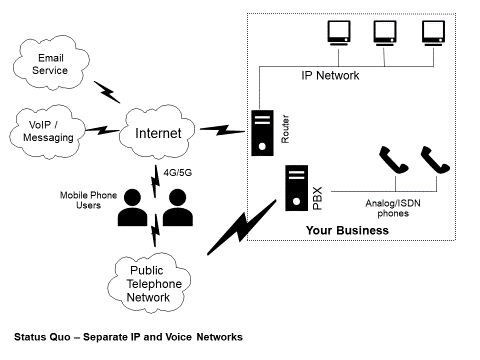
Step One
The next figure shows the introduction of a UCaaS subscription providing messaging, collaboration, IM, on net VoIP and presence. Note that at this stage the client continues to use its legacy / on-premise PBX for calls to / from the Public Switched Telephone Network (PSTN).
At this stage, employees can call each other (and business partners with accounts on the UCaaS service) for free in HD Voice as well as enjoy features like business grade instant messaging and presence, integration to calendars and address books as well as screen and whiteboard sharing regardless of where they are in the world as long as they have an Internet connection and a smartphone, tablet or PC. These services can be offered over the public Internet or over a private IP based wide area network (WAN).
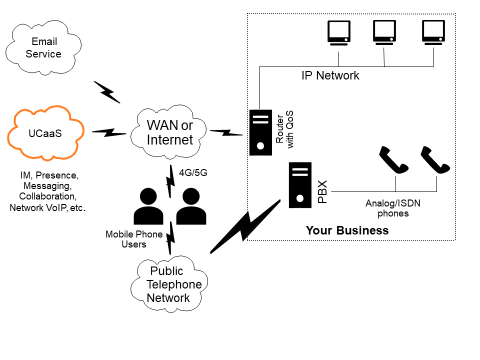
Calls to / from public telephone networks route through the organisation’s existing PBX, desk phones and service provider as usual.
Step Two
In the next stage of the rollout, a gateway is placed ahead of the PBX enabling outgoing telephone calls to be made to the Public Switched Telephone Network (PSTN) via the SIP trunks of the UCaaS service provider or an Internet Telephony Service Provider (ITSP).
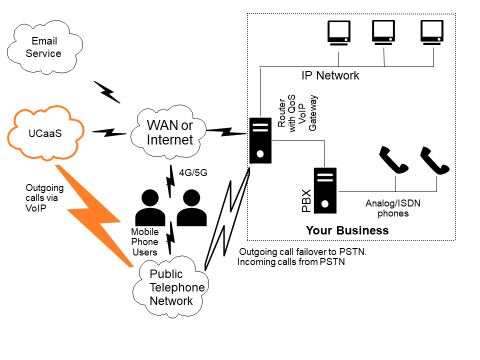
Depending on call charges in the region of the world in which the client is based, the WAN might only be used for international, long distance and inter-office calls. Should VoIP also provide savings on the cost of local outgoing calls, the client might also place these calls via the WAN or Internet.
This figure assumes that incoming calls continue to be routed to the client via its existing PSTN lines given that these lines are known or advertised to the client’s current and potential business partners or clients. These PSTN lines provide for failover for outgoing calls in the event of a problem on the WAN.
Step Three
Telephone numbers originally registered by an incumbent service provider could however be ported to the UCaaS service provider or ITSP, thus enabling incoming calls to be routed to the client via the SIP trunks.
A UCaaS service provider or ITSP can offer its clients this functionality when the country in which they are based retires its legacy telephone network in favour of an IP network but the client is not yet ready to retire its legacy on-premise PBX.
In this scenario, SIP trunks replace the public telephone network lines for incoming and outgoing calls. Any calls made to and received from the public telephone network are now connected not at the organisation’s premises but via interconnects at the UCaaS service provider or ITSP.
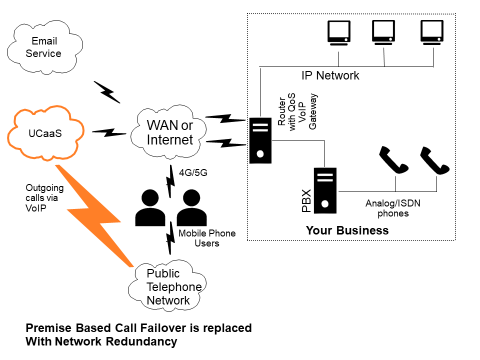
Given that the legacy public telephone trunks to the customer’s premises are no longer available for failover, this scenario assumes that the client organisation has sufficient redundancy at the access network level.
Step Four
The final stage is the removal of the legacy on-premise PBX and all legacy telephones which are replaced by hard or soft SIP phones. Call control is now provided by the IP PBX component of the UCaaS service.
Mobile devices can be full working mobile extensions of the IP PBX using mobile Unified Communications clients / user interfaces. This removes the need for desk phones since users’ smartphones can be utilised over the corporate WiFi network or over mobile data networks.
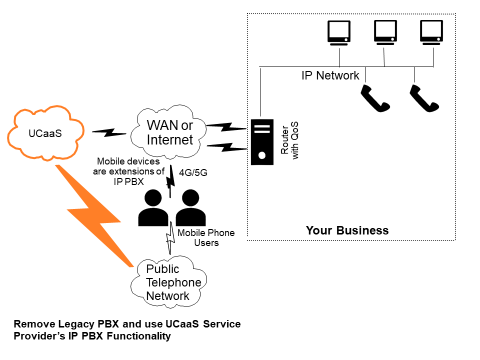
Reconciliation of employee claims for business calls made from personal phone accounts is now a thing of the past since all calls to / from the Public Telephone Network can be made via the IP PBX. Internal calls between employees are free and in HD Voice.
In addition, SMEs can stop advertising the mobile telephone numbers of their employees to their clients by enabling all voice communication between employees and clients to take place via the IP PBX.
How will our UCaaS Platform help you and your SME Clients?
Zwana ICT & Consulting is a channel partner for the scalable multi-tenant unified communications as a service (UCaaS) and communications platform as a service (CPaaS) offerings of leading South African unified communications provider Telviva Software International.The Telviva One Unified Communications service makes it easy and affordable for you as a service provider to help your clients improve their real-time communications and collaboration, thus giving you and your clients a quick return on your respective financial investments.
Telviva Software International offers Telviva One out of Amazon Web Services’ (AWS) secure infrastructure in Ireland. Should you wish, you may also host Telviva One in your own Cloud. Either way, you may white label the service to reflect your own branding and identity.
Telviva One gives you the tools to retain your existing clients and generate new business by meeting the current and developing real-time communications needs of small and medium businesses instead of their using your infrastructure just to access the services of third party over the top (OTT) providers.
By offering your clients the Telviva One platform, they will enjoy multiple benefits such as:
- Their staff can work productively wherever they happen to be – in the office, on the road, at home or on the other side of the world – while enjoying carrier grade rich communications and collaboration tools such as:
- HD Voice and Video calling / conferencing
- A full-featured IP PBX
- Presentation sharing / Web conferencing
- They have the tools to run a virtual office if they wish, thus reducing the costs of office rentals and giving them the flexibility to employ home based workers including workers with disabilities or skilled workers who are geographically distant and who would be unavailable to the organisation in a traditional office environment
- You can provide their staff with their own work telephone number. Prospects and clients can thus call this number and staff can answer these calls on their preferred device wherever they happen to be in the world, as long as they have a data connection. Similarly, staff can call customers via the IP PBX and from their preferred devices while these calls can be recorded for legal purposes. Furthermore, the employer no longer needs to manage employees` claims for business use of private phone accounts since all calls can be made and received through the IP PBX
- By providing staff with their own work telephone numbers, your clients’ staff need not provide their customers with their cell phone numbers. This allows staff to separate their personal from their private lives (since they can just switch off their work phone number after work hours)
- Staff can call each other or take part in conference calls for free, regardless of where the participants are in the world. Because these calls are in HD, the user experience is much better than conference calls taking place via traditional public fixed line and mobile telephone networks
- Staff travelling overseas needn’t pay roaming fees to stay in contact with fellow employees and clients
- If your clients do business overseas, they can be given phone numbers in foreign countries as extensions of their IP PBX so that they have an overseas ‘presence’
- Because services are offered on a per user per month basis without any long-term contracts, your clients can ramp up the use of your services as required seasonally (e.g. if they have to take on extra staff at the end of their financial year) and similarly decrease their usage of your services as and when required. This flexibility is not available to organisations that use in-house solutions requiring up-front commitments to financial, human and infrastructure resources
- Because Telviva One is offered in the Cloud from redundant infrastructures in secure state of the art data centres, your staff will be able to access the service and hence their information, business partners, customers and prospects even if their offices have been disabled by equipment theft, natural disasters, power outages etc.
- Your clients can pilot Telviva One in one department of their organisation where the return on investment will be greatest before rolling it out to other departments
- It’s easy for you to migrate your clients’ current legacy PBX environments to Telviva One without their having to ‘rip and replace’ their existing investments if they haven’t reached end of life. This enables them to take advantage of the benefits of VoIP and SIP trunking before subscribing to the full range of Telviva One’s unified communications and collaboration services
- Because Telviva One offers a suite of Unified Communications services, not just VoIP solutions, your clients will enjoy value added benefits that go far further than just cheaper telephone calls whose benefits are being eroded as interconnect pricing falls
- Scarce capital that your clients would have spent upfront to purchase software, licenses and infrastructure is converted to predictable operating expenditure. This translates to predictable revenues for you as a Service provider
- Organisations using the Telviva One service require fewer costly technical staff since the applications and infrastructure reside in Telviva International’s data centres
- Telviva One can be deployed much more rapidly than premise-based solutions with a corresponding decrease in time to value
- Telviva One is available in two offerings – an Essentials offering and a Premium offering in order to align to the requirements of your clients. The offerings are similar except that the Premium offering includes video conferencing.
In Conclusion
Unified communications and collaboration services provide organisations with measurable financial benefits as well as less easily quantified ‘soft’ benefits which nevertheless improve the organisation’s business processes.
As a Telco, an ISP or a system integrator, you can meet the current and developing real-time communications requirements of your existing clients as well as grow your market share by offering these services to new clients. This allows you to generate value added income from your networks instead of merely being a bitpipe over which your clients access the services of third party over the top (OTT) providers.
The move of PSTN networks to an all-IP environment further provides you with an opportunity to take on new clients, even if they don’t want to retire their legacy PBX infrastructure immediately, by providing them with SIP trunking services as a first step in their journey to becoming users of a full unified communications service.
Zwana ICT & Consulting, through its relationship with Telviva Software International, makes it easy for service providers and their clients in turn to enjoy an affordable quick time to value mobile Cloud unified communications service. This enables organisations of all kinds and sizes to enjoy the cost savings and productivity / business process benefits that are obtainable not just from VoIP but from a full suite of unified communications and collaboration tools including an IP PBX.
If you like what you’ve read in this white paper and on our website and would like further information, including the opportunity for us to demo Telviva One to you, please contact us by clicking here .
About Telviva Software International
Telviva Software International (https://telviva.com) is the international arm of leading South African Unified Communications as a Service provider Telviva.
Having been involved with the first commercial ISP in the country, representing the largest ISP in Africa in the year 2000 having expanded its operations into 6 African Countries, the executive team of Telviva has extensive Internet experience and a profound understanding of how technology can solve real-world business challenges.
Its executive team also features some of the pioneers of Internet Protocol PBX in South Africa As the country’s market leader in multi-tenant cloud PBX communications, Telviva extended the solution to create its flagship product Telviva One, a cloud-based unified communications platform serving over 75 000 users at over 2 500 sites.
Telviva One is the result of the Telviva team’s deep understanding of business processes garnered over twenty years of developing intelligent communications solutions that enhance the way people work.
About Zwana ICT & Consulting
Zwana ICT & Consulting (https://www.zwana.net) has more than 10 years of experience in the unified communications field.
This experience was obtained as a distributor for a US / European vendor of unified communications solutions. During this time we also launched a cloud based provider of unified communications, IP PBX, SIP trunking and WebRTC services.
We target:
- Tier 2 and tier 3 UK and European ISPs and telcos as well as system integrators that wish to upsell value-added white label unified communications services to attract and retain clients
- Small and medium businesses in South Africa that wish to improve their communications, collaboration and business processes and thereby their competitiveness.
We take care to understand your goals, challenges, pain points and needs and will only recommend our offerings to you if we believe they will exceed your expectations. We are after all working in the SaaS environment and would like to have you as a client for many years to come.
PDF Version of this White Paper
A PDF version of this white paper is available from this page.
